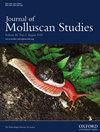Richness, abundance and spatial heterogeneity of gastropods and bivalves in coral ecosystems across the Mexican Tropical Pacific
IF 1.2
4区 生物学
Q2 MARINE & FRESHWATER BIOLOGY
引用次数: 4
Abstract
The diversity of gastropods and bivalves, total mollusc richness and total mollusc abundance were analysed for three substrates (coral, rock and sand) in the coral and reef ecosystems of the Mexican Tropical Pacific (MTP). Up to 3,828 individuals (70% gastropods and 30% bivalves), belonging to 209 species (146 gastropods and 63 bivalves), were identified; this is one of the most diverse molluscan faunas (2.77 species/m2) associated with reef systems in the MTP. Evaluation of the sampling effort demonstrated that 80% of gastropod species and 93% of bivalve species inhabiting the reef system were recovered. The highest abundance occurred in the coral substrate (1,939 individuals), while the highest species richness was found on the rock substrate (131 species). The analysis showed that the greatest spatial variation in total mollusc, gastropod and bivalve diversity occurred among different substrates within individual localities, with minor differences among assemblages with increasing spatial scale reflecting the relative homogeneity of the molluscan fauna in the study area. While the gastropods Conus nux, Steironepion piperatum and Muricopsis zeteki accounted for differences among different regions, and Vermicularia pellucida eburnea and Bostrycapulus aculeatus accounted for differences among states, the abundances of M. zeteki, B. aculeatus and V. pellucida eburnea were related to differences in diversity at the scale of individual localities. Among bivalves, Leiosolenus aristatus, L. plumula and Gastrochaena ovata accounted for differences between regions, states and localities, respectively. Overall, the study shows that species composition is influenced by both the substrate and the geographical location of assemblages. This indicates that conservation strategies should address preserving habitat heterogeneity at local scales in the study area.墨西哥热带太平洋珊瑚生态系统中腹足类和双壳类的丰富度、丰度和空间异质性
分析了墨西哥热带太平洋珊瑚礁生态系统中三种基质(珊瑚、岩石和沙子)的腹足类和双壳类的多样性、软体动物总丰富度和软体动物总丰度。鉴定出多达3828个个体(70%的腹足类和30%的双壳类),隶属于209种(146种腹足类,63种双壳类;这是MTP中与珊瑚礁系统相关的最多样的软体动物群之一(2.77种/m2)。对采样工作的评估表明,栖息在珊瑚礁系统中的80%的腹足类物种和93%的双壳类物种被恢复。丰度最高的是珊瑚基质(1939个个体),而物种丰富度最高的是岩石基质(131个物种)。分析表明,软体动物、腹足类和双壳类总多样性的最大空间变化发生在各个地区的不同基质之间,随着空间尺度的增加,组合之间的差异较小,反映了研究区域软体动物区系的相对同质性。虽然腹足类Conus nux、Steironepion pipatum和Muricopsis zeteki解释了不同地区之间的差异,而Vermicularia pellucida eburnea和Bostrycapulus acureatus解释了各州之间的差异。在双壳类中,Leiosolinus aristatus、L.plumbula和Gastrochaena ovata分别解释了地区、州和地方之间的差异。总体而言,研究表明,物种组成受基质和组合地理位置的影响。这表明,保护策略应在研究区域的地方尺度上解决保护栖息地异质性的问题。
本文章由计算机程序翻译,如有差异,请以英文原文为准。
求助全文
约1分钟内获得全文
求助全文
来源期刊

Journal of Molluscan Studies
生物-动物学
CiteScore
3.00
自引率
8.30%
发文量
36
审稿时长
3 months
期刊介绍:
The Journal of Molluscan Studies accepts papers on all aspects of the study of molluscs. These include systematics, molecular genetics, palaeontology, ecology, evolution, and physiology. Where the topic is in a specialized field (e.g. parasitology, neurobiology, biochemistry, molecular biology), submissions will still be accepted as long as the mollusc is the principal focus of the study, and not incidental or simply a convenient experimental animal. Papers with a focus on fisheries biology, aquaculture, and control of molluscan pests will be accepted only if they include significant advances in molluscan biology. While systematic papers are encouraged, descriptions of single new taxa will only be considered if they include some ‘added value’, for example in the form of new information on anatomy or distribution, or if they are presented in the context of a systematic revision or phylogenetic analysis of the group.
 求助内容:
求助内容: 应助结果提醒方式:
应助结果提醒方式:


